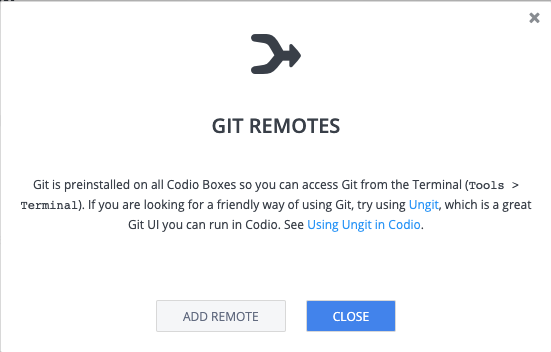

- #CODIO GIT ADD REMOTE HOW TO#
- #CODIO GIT ADD REMOTE PRO#
- #CODIO GIT ADD REMOTE LICENSE#
- #CODIO GIT ADD REMOTE WINDOWS#
All sites like this can be found using this pattern for the URL: Since the project you forked creates a website, its main branch is 'gh-pages'. will automatically serve and host static website files in branches named 'gh-pages'. This way you can do your work while the main, commonly named 'master', branch stays stable. It's common practice when working on a project or with others on a project to create a branch to put your changes in. Git repositories use branches to isolate work when needed. Ĭreate a new branch for your contribution. But make sure you aren't cloning it inside of another Git repository folder! So, if you're still inside of the repository you created in the early challenges, back out of that folder: cd. It will create a new folder for the repository so no need to create one. Copy your fork's HTTP URL on the right side. Once the fork animation is complete, you've got a copy on your account. The project we'll work with is Go to that site and click the fork button at the top right. Once a project is forked, you then clone (aka copy) it from GitHub to your computer to work on locally. Forks are used for creating your own version of a project or contributing back fixes or features to the original project. When you fork a repository, you're creating a copy of it on your account. The other half is working with other people and projects. Now you've made a project locally and pushed it to GitHub, but that's only half the fun. This is commonly named origin.įork a project from and clone it locally. At the top you'll see 'Quick Setup', make sure the 'HTTP' button is selected and copy the address - this is the location of your repository on GitHub.īack in your terminal, and inside of the folder that you initialized as a Git repository in the previous challenge, you want to tell Git the location of the remote version. Now you've got an empty repository started on.
#CODIO GIT ADD REMOTE LICENSE#
A license file is the type of license you put on your project, information on the types can be found at We don't need them, however, for this example.gitignore is a list of files that Git should not track (for instance, files with passwords!).

#CODIO GIT ADD REMOTE HOW TO#
#CODIO GIT ADD REMOTE WINDOWS#
You'll need some basic terminal (Bash) commands (see below) for moving around and creating folders (just like you'd do in Finder or Windows Explorer). You're going to create a new folder and initialize it as a Git repository. Files added or subtracted or even a single letter in a single file added - all of it's tracked and time stamped by Git. You tell Git what your project is and Git will start tracking all of the changes to that folder. In fact, that's what it will look like on your computer anyways. You can imagine it as project's folder with all the related files inside of it. Some of the challenges are longer than the screen, so don't forget to scroll up to where it begins after it loads!Ī repository is essentially a project.

When you finish each challenge, type git-it to see the menu and go to the next challenge. You don't actually type it in, though, only type git-it verify.
#CODIO GIT ADD REMOTE PRO#
PRO TIP: Dollar signs are often used in programming documentation to signify that the line is command line code.


 0 kommentar(er)
0 kommentar(er)
